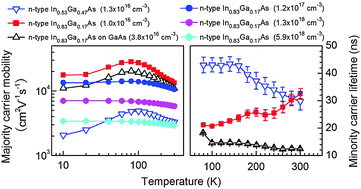Carrier scattering and relaxation dynamics in n-type In0.83Ga0.17As as a function of temperature and doping density
Abstract
The carrier scattering and relaxation dynamics in an n-type In0.83Ga0.17As ternary alloy are investigated by measuring the temperature dependent electron Hall mobilities and the hole lifetimes as a function of doping density. The dominant scattering mechanisms in temperature ranges of T < 80 K, 80 < T < 120 K, and 120 < T < 300 K in lightly doped In0.83Ga0.17As are found to be impurity scattering, alloy disorder scattering and phonon scattering, respectively, while in heavily doped In0.83Ga0.17As alloy scattering dominates over the whole measured temperature range. By fitting the measured temperature dependent carrier lifetimes, the dominant carrier relaxation mechanisms in lightly doped In0.83Ga0.17As are identified to be the radiative recombination and the Shockley–Read–Hall effect for samples grown on InP and GaAs substrates, respectively. The lifetime in heavily doped In0.83Ga0.17As is below 10 ns with an Auger dominated recombination. Lastly, photoluminescence as well as the light absorption measurements are performed, showing that the grown lightly doped In0.83Ga0.17As has a high optical quality comparable to the lattice-matched In0.53Ga0.47As.


 Please wait while we load your content...
Please wait while we load your content...